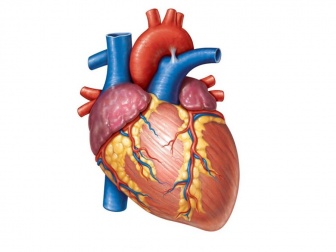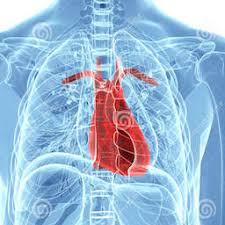Anatomy of the Human Heart: Difference between revisions
No edit summary |
No edit summary |
||
| Line 16: | Line 16: | ||
== Anatomy == | == Anatomy == | ||
[[File:Human-heart-diagram.jpg|thumb|336x336px]] | |||
The general shape and orientation of the heart are that of a pyramid that has fallen over and is resting on one of its sides. Placed in the thoracic cavity, the apex of this pyramid projects forward, downward, and to the left, whereas the base is opposite the apex and faces in a posterior direction. | The general shape and orientation of the heart are that of a pyramid that has fallen over and is resting on one of its sides. Placed in the thoracic cavity, the apex of this pyramid projects forward, downward, and to the left, whereas the base is opposite the apex and faces in a posterior direction. | ||
The average adult’s heart is about 5.5 inches (14 centimeters) long and 3.5 inches (9 centimeters) wide, or approximately the size of one’s fist and also varies with body size. In an infant, the heart is about a thirtieth of total body weight. In an average adult, the heart is about one three-hundredth of total body weight; this equals about 11 ounces (310 grams) in males and 8 ounces (225 grams) in females. | The average adult’s heart is about 5.5 inches (14 centimeters) long and 3.5 inches (9 centimeters) wide, or approximately the size of one’s fist and also varies with body size. In an infant, the heart is about a thirtieth of total body weight. In an average adult, the heart is about one three-hundredth of total body weight; this equals about 11 ounces (310 grams) in males and 8 ounces (225 grams) in females<ref>Balaban, NE, Bobick, J, Cardiovascular system.The Handy Anatomy Answer Book. Detroit:Visible Ink Press, 2008. P197.</ref>. | ||
=== Location of the Heart === | === Location of the Heart === | ||
The heart is roughly in a plane that runs from the right shoulder to the left nipple. It lies in the protective thorax, posterior to the sternum and costal cartilages, and rests on the superior surface of the diaphragm. The heart is located between the two lungs in the space referred to as the ''mediastinum''("that which stands in the middle"). The human heart assumes an oblique position in the thorax, one-third of the heart is located on the right side, while two thirds is located on the left side of midline. The base is located below the third rib as it approaches the sternum (note that the sternal angle occurs at the level of the second rib). The base is directed superiorly to the right of midline and posterior. The pointed apex projects to the left of midline and anterior. Thus, the heartbeat can be most easily palpated at the left fifth intercostal space, 8-9 cm from the midsternal line (just inferior to the left nipple). | [[File:Heart location.jpg|thumb]] | ||
The heart is roughly in a plane that runs from the right shoulder to the left nipple. It lies in the protective thorax, posterior to the sternum and costal cartilages, and rests on the superior surface of the diaphragm. The heart is located between the two lungs in the space referred to as the ''mediastinum''("that which stands in the middle"). The human heart assumes an oblique position in the thorax, one-third of the heart is located on the right side, while two thirds is located on the left side of midline. The base is located below the third rib as it approaches the sternum (note that the sternal angle occurs at the level of the second rib). The base is directed superiorly to the right of midline and posterior. The pointed apex projects to the left of midline and anterior. Thus, the heartbeat can be most easily palpated at the left fifth intercostal space, 8-9 cm from the midsternal line (just inferior to the left nipple). | |||
=== Layers of the Heart Walls === | === Layers of the Heart Walls === | ||
The heart wall consists of three layers: | |||
'''Epicardium''' - the outer layer of the wall of the heart and is formed by the visceral layer of the serous pericardium. | |||
'''Myocardium''' - the muscular middle layer of the wall of the heart and is composed of three discernable layers of muscle that are seen predominantly in the left ventricle and inter-ventricular septum alone. It includes | |||
[[File:Heart wall1.jpg|thumb|333x333px]] | |||
· a subepicardial layer, | |||
· a middle concentric layer | |||
· a subendocardial layer. | |||
The rest of the heart is composed mainly of the subepicardial and subendocardial layers. The myocardium also contains important structures such as excitable nodal tissue and the conducting system. | |||
'''Endocardium''' - the innermost layer of the heart is formed of the endothelium and subendothelial connective tissue | |||
=== Chambers of the Heart === | === Chambers of the Heart === | ||
Revision as of 17:09, 8 March 2018
Original Editor - Your name will be added here if you created the original content for this page.
Lead Editors - Uchechukwu Chukwuemeka, Lucinda hampton, Kim Jackson, George Prudden, Joao Costa, Sai Kripa, Admin and Adam Vallely Farrell
Introduction[edit | edit source]
The heart is a muscular pump that serves two functions; to collect oxygen-poor blood from the tissues of the body and pump this blood to the lungs to pick up oxygen and release carbon dioxide and to collect oxygen-rich blood from the lungs and pump this blood to all of the tissues of the body.
It is important to note that, the blood pumped by the heart also circulates many other important substances such as:
1. Nutrients from digestion are collected from the small intestine and pumped through the circulatory system to be delivered to all cells of the body.
2. Hormones are produced from one type of tissues and distributed to all cells of the body. The circulatory system carries waste materials (salts, nitrogenous wastes, and excess water) from cells to the kidneys, where they are extracted and passed to the bladder.
3. The pumping of interstitial fluid from the blood into the extracellular space is an important function of the heart. Excess interstitial fluid is then returned to the circulatory system via the lymphatic system.
Anatomy[edit | edit source]
The general shape and orientation of the heart are that of a pyramid that has fallen over and is resting on one of its sides. Placed in the thoracic cavity, the apex of this pyramid projects forward, downward, and to the left, whereas the base is opposite the apex and faces in a posterior direction.
The average adult’s heart is about 5.5 inches (14 centimeters) long and 3.5 inches (9 centimeters) wide, or approximately the size of one’s fist and also varies with body size. In an infant, the heart is about a thirtieth of total body weight. In an average adult, the heart is about one three-hundredth of total body weight; this equals about 11 ounces (310 grams) in males and 8 ounces (225 grams) in females[1].
Location of the Heart[edit | edit source]
The heart is roughly in a plane that runs from the right shoulder to the left nipple. It lies in the protective thorax, posterior to the sternum and costal cartilages, and rests on the superior surface of the diaphragm. The heart is located between the two lungs in the space referred to as the mediastinum("that which stands in the middle"). The human heart assumes an oblique position in the thorax, one-third of the heart is located on the right side, while two thirds is located on the left side of midline. The base is located below the third rib as it approaches the sternum (note that the sternal angle occurs at the level of the second rib). The base is directed superiorly to the right of midline and posterior. The pointed apex projects to the left of midline and anterior. Thus, the heartbeat can be most easily palpated at the left fifth intercostal space, 8-9 cm from the midsternal line (just inferior to the left nipple).
Layers of the Heart Walls[edit | edit source]
The heart wall consists of three layers:
Epicardium - the outer layer of the wall of the heart and is formed by the visceral layer of the serous pericardium.
Myocardium - the muscular middle layer of the wall of the heart and is composed of three discernable layers of muscle that are seen predominantly in the left ventricle and inter-ventricular septum alone. It includes
· a subepicardial layer,
· a middle concentric layer
· a subendocardial layer.
The rest of the heart is composed mainly of the subepicardial and subendocardial layers. The myocardium also contains important structures such as excitable nodal tissue and the conducting system.
Endocardium - the innermost layer of the heart is formed of the endothelium and subendothelial connective tissue
Chambers of the Heart[edit | edit source]
Heart Valves[edit | edit source]
Blood Supply[edit | edit source]
Nerve Supply[edit | edit source]
Clinical Relevance[edit | edit source]
Embroyology[edit | edit source]
Histology[edit | edit source]
Resources[edit | edit source]
Recent Related Research (from Pubmed)[edit | edit source]
Extension:RSS -- Error: Not a valid URL: Feed goes here!!|charset=UTF-8|short|max=10
References[edit | edit source]
- ↑ Balaban, NE, Bobick, J, Cardiovascular system.The Handy Anatomy Answer Book. Detroit:Visible Ink Press, 2008. P197.









